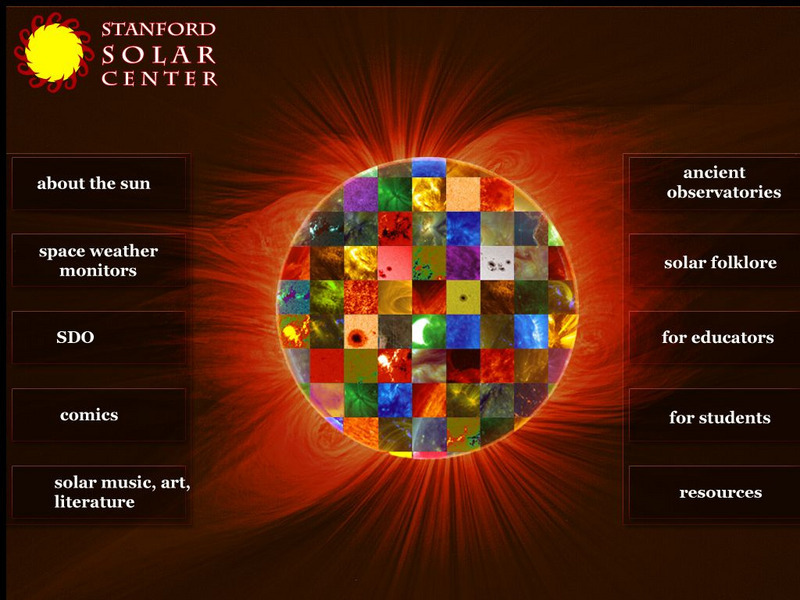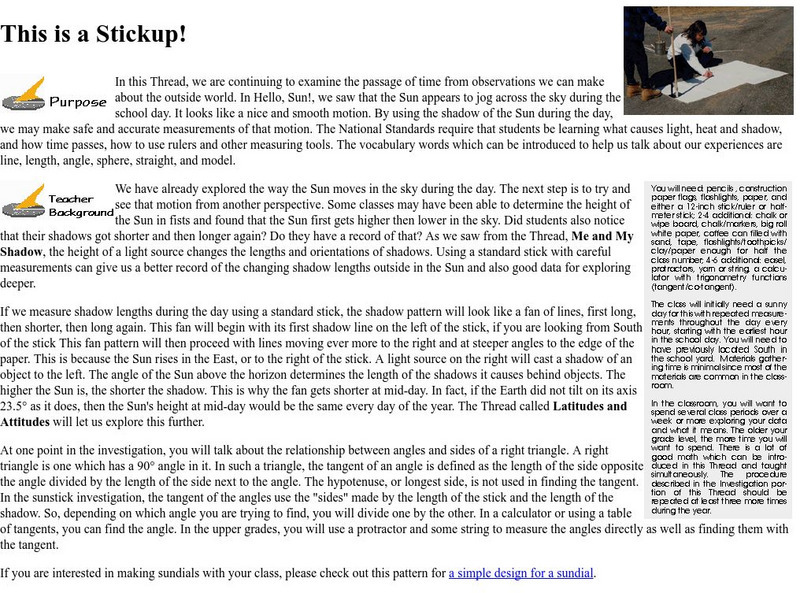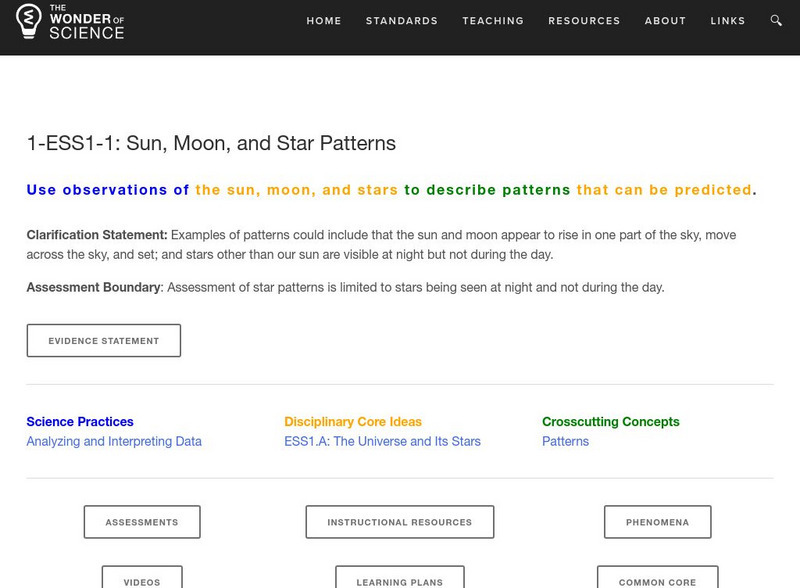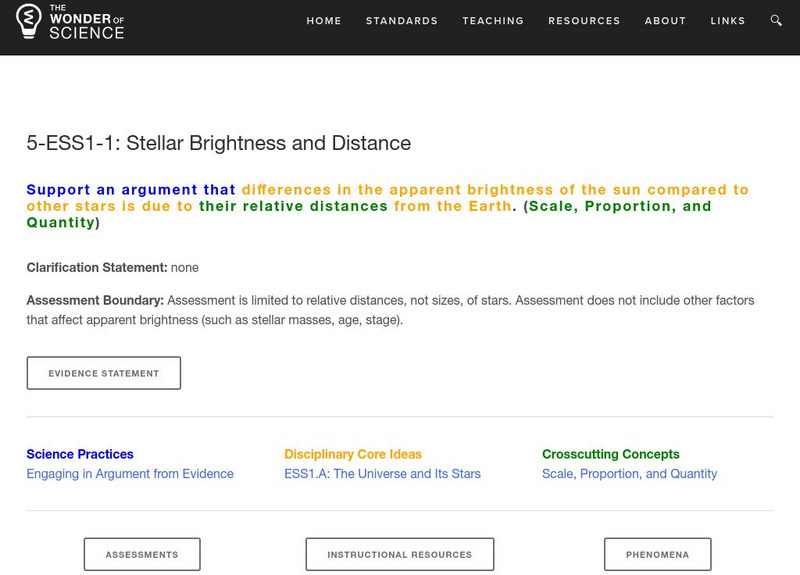NASA
Nasa Star Child: The Solar System
Discover information about parts of the Solar System, along with definitions just by clicking on highlighted vocabulary terms. Be sure to try the "Solar System Activities" to review the material from these pages.
Other
Sea and Sky: The Sky the Sun
This section of The Sky web site focuses on the Sun! Included are basic facts and statistical information as well as dramatic photos from NASA.
Merriam-Webster
Merriam Webster: Dictionary Illustration: Solar Eclipse
Basic diagram of a solar eclipse illustrates the relative positions of the sun, moon, and earth.
University of Chicago
University of Chicago: What's Your Slant? Sun and Shadows
This fun activity helps you to understand the movement of the sun by studying shadows.
Annenberg Foundation
Annenberg Learner: Journey North: Judy Brophy: The Sun's Daily Cycle
Impressive animated slideshow presentation on the sun's daily cycle and how the sunlight changes hour by hour over the course of a day. Includes a teacher guide with lesson plan ideas and activities.
NASA
Nasa Star Child: Star Child
StarChild from NASA defines and describes the Solar System in a simple and easy-to-understand manner. The website is broken down into two versions for the student, grade school and junior high.
Other
The Apollo Society: The Solar System
Contains a small set of images of solar system objects and a series of links to information about all solar system objects. Solar System Tours link to excellent image collections.
Stanford University
Stanford Solar Center: About the Sun
The Stanford Solar Center provides information about the sun, activities, solar art, and solar folklore.
Harvard University
University of Harvard: This Is a Stickup!
Students are taught how to make a sundial. The relationship between angles and the sides of a right triangle are explored. Great lesson plan ideas with plenty of background information. The lesson is adapted for grade levels k-6 with...
Harvard University
Harvard University: The Sun
Includes a brief history of the sun's development and its future. Also provides simple statistics, solar activities, and references.
Atomic Archive
Atomic Archive: Nuclear Fusion
From the Atomic Archive - the online companion to the award-winning CD-ROM. This page defines nuclear fusion and depicts the process by an informative diagram. Includes numerical values which describe the typical energy values for fusion...
NASA
Nasa: Eclipses
The periodicity and recurrance of eclipses is governed by the Saros cycle, a period of approximately 6,585.3 days (18 years 11 days 8 hours). It was known to the Chaldeans as a period when lunar eclipses seem to repeat themselves, but...
Other
University of Leicester: Sun
Provides a brief overview of the Sun, including a focus on solar eclipses, solar wind, and solar sailing.
US Energy Information Administration
U.s. Eia: Energy Kids: Renewable Energy: Solar
This is a resource on solar energy, photovoltaic energy, solar thermal heat, solar thermal power plants and other forms of energy.
E-learning for Kids
E Learning for Kids: Mediterranean Sea: What Sort of Energy Is Provided by the Sun?
Lorani is a mermaid who lives underwater in the ocean. What she loves most in the world is the sun. Join her and learn about the sun, too.
NASA
Nasa Science: For Kids: Solar System Fun
Test your knowledge about the solar system with games and activities designed to help explore what you know about the sun, the planets and their moons, space rocks, the Milky Way, and related topics.
Read Works
Read Works: From Morning to Night
[Free Registration/Login Required] An informational text about how the day moves from morning to night. A question sheet is available to help students build skills in reading comprehension.
Read Works
Read Works: Sunlight in the Night
[Free Registration/Login Required] An informational text about moonlight and where it comes from. A question sheet is available to help students build skills in reading comprehension.
Read Works
Read Works: Article a Day Set: Time: Parts of a Day
[Free Registration/Login Required] ReadWorks provides numerous resources filled with informational articles. "Parts of a Day" provides information about the parts of a day: morning, afternoon, evening, and night. This passage is designed...
Views of the Solar System
Views of the Solar System: Sun
Explore the sun through this site that includes vivid multimedia resources. Learn sun statistics and view numerous images of the sun and eclipses.
National Museums Liverpool
Liverpool Museums: The Sun Tracker
This simulation allows the user to see the sun's arc in the sky anywhere in the world at any time. By changing the season settings the user can see how seasons affect the height of the sun's arc.
The Wonder of Science
The Wonder of Science: 1 Ess1 1: Sun, Moon, and Star Patterns
The NSTA vetted source includes resources to help students describe patterns of the sun, moon, and stars using observation. Included are assessment ideas, videos, examples, lesson plans, and photos of student work.
The Wonder of Science
The Wonder of Science: 5 Ess1 1: Stellar Brightness and Distance
Students will learn about stellar brightness and distance to be able to support their argument about the apparent brightness of our sun compared to other stars due to their distances with these lesson plans.






















